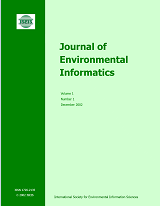© Thomson Reuters Journal Citation Report 2021.
Vol 46, Issue 2 (December 2025)
| Sustainable Utilization Efficiency of Ski Resources in China: An Integrated Natural-Socioeconomic Evaluation Framework, Synergistic Drivers, and Climate Resilient Governance Pathways |
PDF
SI
|
| Y. Li, Z. X. Wang, B. Xia, Z. H. Li, D. H. Shi, J. Zhang, R. R. Gong, W. Yang | 87-101 |
| Study on the Migration and Distribution Characteristics of Microplastics in the Pearl River Estuary under Changing Environmental Conditions |
PDF
SI
|
| G. P. He, H. Wan, R. Li, Y. P. Cai, Z. F. Yang | 102-116 |
| Asymmetric Effect of ICT Penetration, Urban Primacy, and Its Role in GHG Emissions and Renewable Energy Consumption in European Regions |
PDF
|
| D. Singh, G. Tóth | 117-131 |
| An Improved Habitat Quality Assessment Model Considering Vegetation Growth Status: A Case Study of the Qinghai–Tibet Plateau |
PDF
|
| L. L. Zhao, K. Jia, M. Xia, B. Yuan, G. F. Tao, J. Li, Y. R. Cui, Q. Wang | 132-144 |
| Activation of NH3 at Nickel-Induced Lewis Acid Sites over CeVO4 Catalysts for the Selective Catalytic Reduction Nitric Oxide |
PDF
SI
|
| M. L. Xie, F. Guo, Q. Liu, Y. L. Li, G. R. Chen, X. L. Zou, Q. Zhang, J. Y. Zhang, K. Wu, M. H. Duan, J. Q. Xu | 145-158 |
| Collusion or Cooperation — How Public Supervision Affect the Business Government Interaction in Cleaner Production Regulation |
PDF
SI
|
| M. Liu, Y. M. Li | 159-173 |
Aims and Scope
Journal of Environmental Informatics (JEI) is an international, peer-reviewed, and interdisciplinary publication designed to foster research innovation and discovery on basic science and information technology for addressing various environmental problems. The journal aims to motivate and enhance the integration of science and technology to help develop sustainable solutions that are consensus-oriented, risk-informed, scientifically-based and cost-effective. JEI serves researchers, educators and practitioners who are interested in theoretical and/or applied aspects of environmental science, regardless of disciplinary boundaries. The topics addressed by the journal include:
- Planning of energy, environmental and ecological management systems
- Simulation, optimization and Environmental decision support
- Environmental geomatics - GIS, RS and other spatial information technologies
- Informatics for environmental chemistry and biochemistry
- Environmental applications of functional materials
- Environmental phenomena at atomic, molecular and macromolecular scales
- Modeling of chemical, biological and environmental processes
- Modeling of biotechnological systems for enhanced pollution mitigation
- Computer graphics and visualization for environmental decision support
- Artificial intelligence and expert systems for environmental applications
- Environmental statistics and risk analysis
- Climate modeling, downscaling, impact assessment, and adaptation planning
- Other areas of environmental systems science and information technology
© 2025 ISEIS - International Society for Environmental Information Sciences
